Schönefeld, Helmut, born 27-03-1916 in Erlangen, Germany  the son of a theologian and classical philologist, he was born in Erlangen. After graduating from high school in 1934 in Eisenach, Thuringia, Helmut became a soldier and began his career as an officer cadet in the 1st Prussian Intelligence Department in Königsberg, Prussia.
the son of a theologian and classical philologist, he was born in Erlangen. After graduating from high school in 1934 in Eisenach, Thuringia, Helmut became a soldier and began his career as an officer cadet in the 1st Prussian Intelligence Department in Königsberg, Prussia. 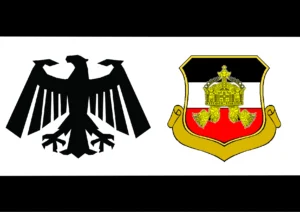 Helmut was trained as an officer at the Infantry School in Dresden and the Army Intelligence School in Halle. On 01-04-1936, he was promoted to lieutenant. In 1942, he was trained as a general staff officer. He served, among other positions, as a general staff officer in the Operations Department of the Army General Staff under General Heusinger, Adolf Bruno Heinrich Ernst and Wenck.
Helmut was trained as an officer at the Infantry School in Dresden and the Army Intelligence School in Halle. On 01-04-1936, he was promoted to lieutenant. In 1942, he was trained as a general staff officer. He served, among other positions, as a general staff officer in the Operations Department of the Army General Staff under General Heusinger, Adolf Bruno Heinrich Ernst and Wenck.

 At the end of the war, Schönefeld was the 1st General Staff Officer (I a) of the “Hoch- und Deutschmeister” Division of the 44th Infantry Division (Wehrmacht)
At the end of the war, Schönefeld was the 1st General Staff Officer (I a) of the “Hoch- und Deutschmeister” Division of the 44th Infantry Division (Wehrmacht) ![]() under command of Generalleutnant Heinrich-Anton Deboi
under command of Generalleutnant Heinrich-Anton Deboi 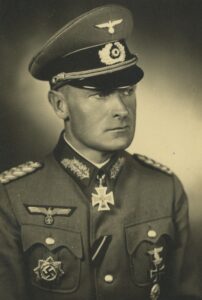
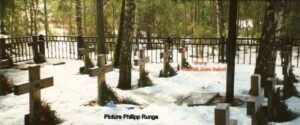
After 1945, he worked as a bricklayer and brickworker in Westphalia. He studied construction engineering (specializing in architecture) at the Technical University of Hanover and graduated in 1949 with a diploma (Dipl.-Ing.). From 1950 to 1955, Helmut worked as a research assistant at the Institute for Construction Research in Hanover under Wolfgang Triebel. He received his doctorate in 1953 with a thesis on the rationalization of conventional construction methods in terms of work technology and work physiology.In 1956, Schönfeld joined the Bundeswehr,  which was still in its infancy, as a lieutenant colonel. He initially worked in the Bundeswehr’s General Staff and in the Territorial Defense Command, where, among other things, he was responsible for fortified installations and was responsible for resuming the work of the former fortress engineers. From 1959 to 1963, he was commander of an engineer regiment. During this period, the first heavy-duty floating bridge for all military load classes was built across the Rhine.
which was still in its infancy, as a lieutenant colonel. He initially worked in the Bundeswehr’s General Staff and in the Territorial Defense Command, where, among other things, he was responsible for fortified installations and was responsible for resuming the work of the former fortress engineers. From 1959 to 1963, he was commander of an engineer regiment. During this period, the first heavy-duty floating bridge for all military load classes was built across the Rhine. 
In 1963, Schönefeld became the advisor for armaments matters in the Army Staff. During this period, decisions were made regarding the introduction of the Leopard main battle tank, the requirements for the development of the German infantry fighting vehicle “family,” the further development of the Army’s anti-tank and anti-aircraft weapons, and the first negotiations on the multilateral development of, among other things, main battle tanks, artillery weapons, and reconnaissance drones within NATO. From 01-04-1966, Schönefeld headed the Land Defense Technology Sub-Directorate in the Federal Ministry of Defense. In international armaments cooperation, he represented the Federal Minister of Defense, among other things, in NATO’s top committee for issues relating to the armament of land forces.
Death and burial ground of Helmut Schönefeld.

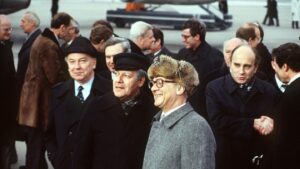
On 01-08-1966, Schönefeld was promoted to Brigadier General. In 1968 he took command of the 4th Panzergrenadier Division in Regensburg and was promoted to Major General on 04-11-1968. In the autumn of 1970, Schönefeld succeeded General Karl Wilhelm Thilo 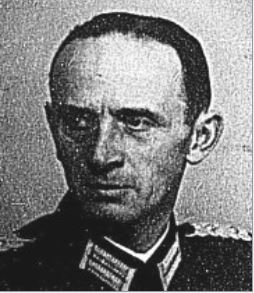 as Lieutenant General and commanding general of the II Corps in Ulm. In 1976, Schönefeld retired and spent his time in Bonn-Bad Godesberg. Helmut Schönefeld died 15-04-1997, age 81, in Bonn, Germany and is buried at the Zentralfriedhof Bad Godesberg in Bonn, Germany.
as Lieutenant General and commanding general of the II Corps in Ulm. In 1976, Schönefeld retired and spent his time in Bonn-Bad Godesberg. Helmut Schönefeld died 15-04-1997, age 81, in Bonn, Germany and is buried at the Zentralfriedhof Bad Godesberg in Bonn, Germany.








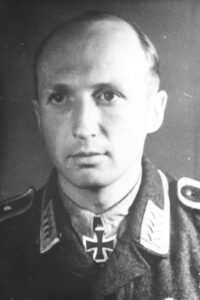









Leave a Reply